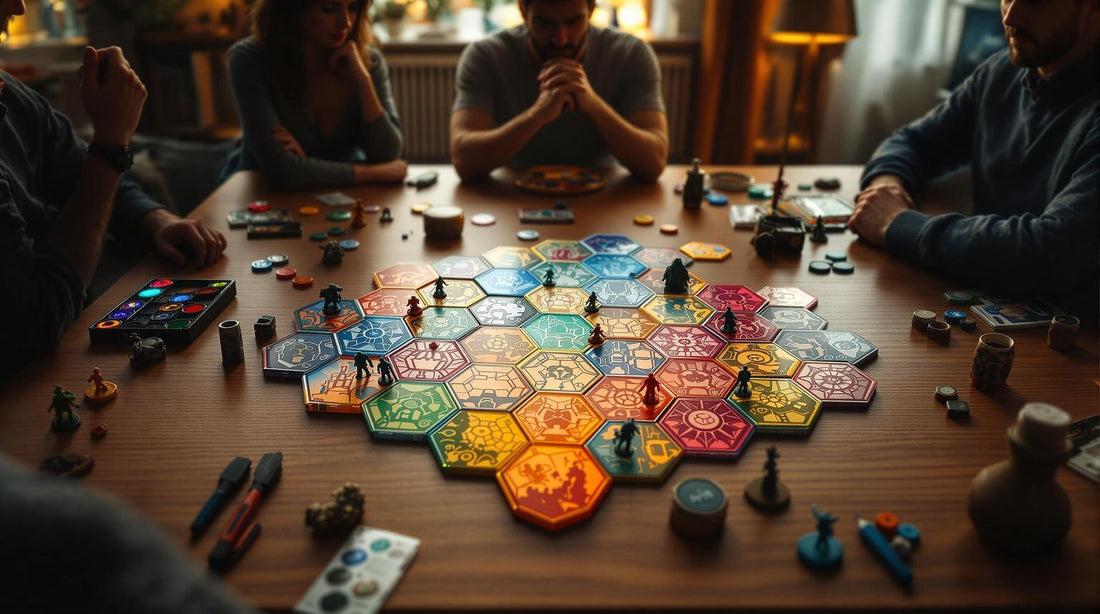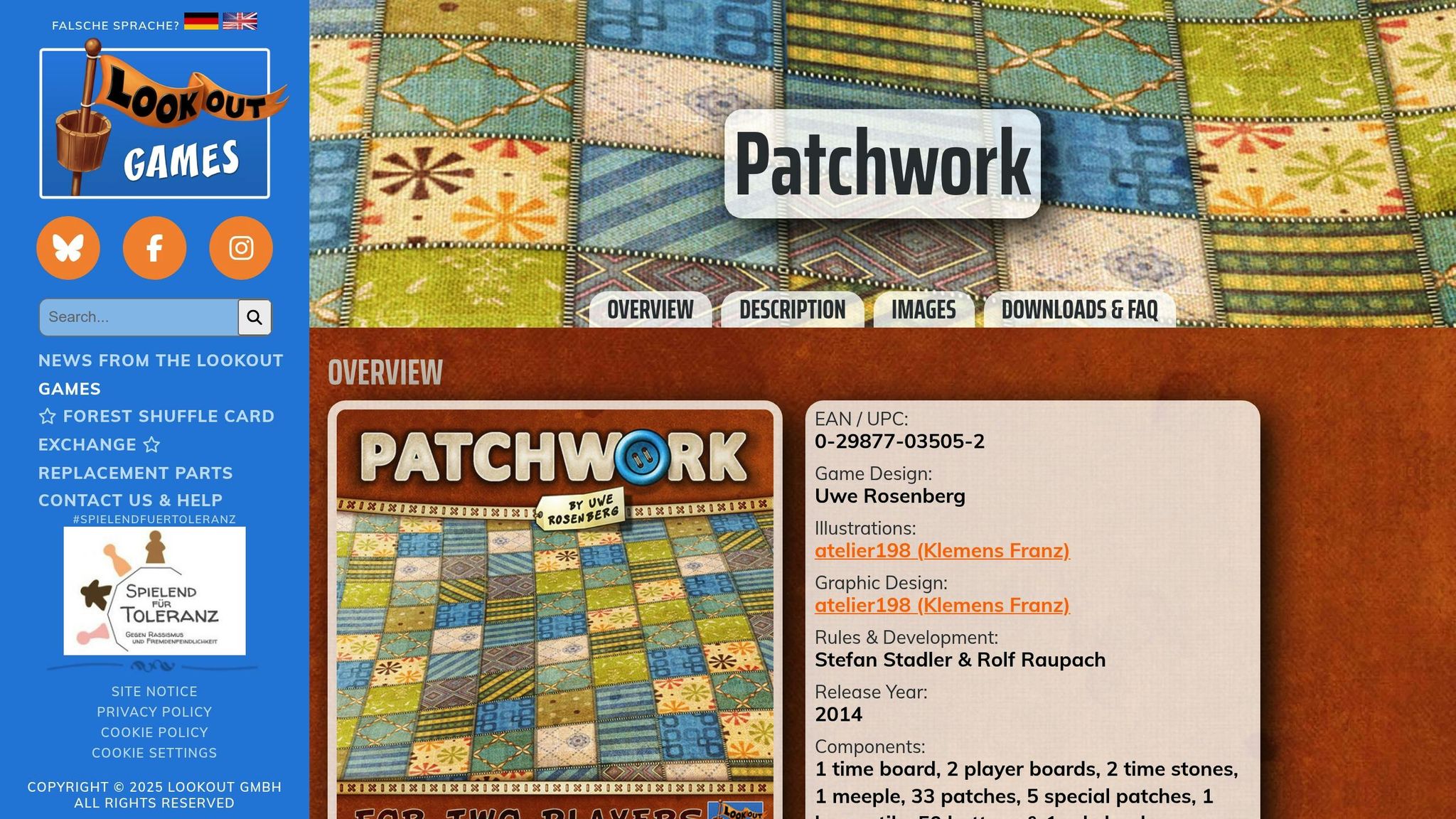Discover the Best Board Games for Every Player

Top 10 Abstract Strategy Games 2025
Abstract strategy games are all about skill - no luck, no randomness, just pure decision-making. They’re easy to learn but take time to master, making them perfect for players who love thoughtful challenges. Here's a quick look at the best abstract strategy games of 2025:
- Hive: Dynamic, insect-themed gameplay where the board evolves with every move. Goal: Surround your opponent's Queen Bee.
- Azul: Draft colorful tiles to create patterns while balancing risk and reward.
- Santorini: Build and climb structures on a 3D grid with unique god powers.
- Onitama: A tight 2-player game with rotating movement cards and focused tactics.
- Tak: Inspired by literature, connect roads across the board with stacking mechanics.
- The Duke: Flip tiles to reveal new moves in this chess-like duel.
- Blokus: A spatial strategy game where you expand territory using Tetris-like pieces.
- Quarto: Choose pieces for your opponent, aiming to align traits on a 4x4 board.
- YINSH: Form rows of five markers while managing the trade-off of losing rings.
- Patchwork: A 2-player puzzle game combining resource management and spatial planning.
These games stand out for their simplicity, depth, and replayability. Whether you're new to abstract strategy or a seasoned player, there’s something for everyone.
Quick Comparison Table
| Game | Player Count | Duration | Key Mechanic | Complexity |
|---|---|---|---|---|
| Hive | 2 | 20 mins | Dynamic board, insect movement | Medium |
| Azul | 2–4 | 30–45 mins | Tile drafting, pattern building | Low |
| Santorini | 2–4 | 10–20 mins | 3D building, god powers | Medium |
| Onitama | 2 | 15–20 mins | Rotating movement cards | Low |
| Tak | 2 | 20–40 mins | Road building, stacking pieces | High |
| The Duke | 2 | 30 mins | Tile flipping, chess-like | Medium |
| Blokus | 2–4 | 20–30 mins | Spatial strategy, polyomino pieces | Low |
| Quarto | 2 | 15 mins | Forced-piece placement | Medium |
| YINSH | 2 | 30 mins | Marker rows, ring trade-offs | High |
| Patchwork | 2 | 30 mins | Resource management, puzzles | Low |
Each game offers a unique twist on strategy - dive into the full list to find your next favorite!
Azul Games Reviewed, Compared and Ranked

1. Hive

Hive stands out as an abstract strategy game where the playing field isn't fixed - it forms and shifts as the game progresses.
How It Works
The game uses insect-themed pieces, each with its own movement rules. The goal? Surround your opponent's Queen Bee completely. Here's a quick look at the insects and their moves:
- Queen Bee: Moves one space at a time.
- Beetle: Can climb on top of other pieces.
- Grasshopper: Jumps over other pieces in straight lines.
- Spider: Moves exactly three spaces.
- Ant: Moves freely along the hive's edge.
This dynamic setup creates endless possibilities for tactical maneuvers.
Pure Strategy
Hive is all about skill and planning - there's no luck involved. Every move you make shapes the hive and your strategy, keeping the game fresh and evolving.
What Makes It Fun
Designed for two players, Hive delivers intense, head-to-head gameplay. With a constantly changing board, no two matches are the same, offering endless replay value for both casual gamers and hardcore strategy fans.
2. Azul
Tile Drafting with a Twist
In Azul, players take on the role of artisans decorating the walls of the Royal Palace of Evora. The game revolves around a clever tile-drafting system. You pick vibrant tiles from shared factory displays and place them on your personal board. Every choice matters, setting the stage for thoughtful and strategic gameplay.
Easy to Learn, Challenging to Master
The rules of Azul are straightforward, but the strategy runs deep. Deciding which tiles to draft and where to position them on your board is key to racking up points. It's a game where simple mechanics lead to complex decision-making.
Balancing Risk and Reward
Scoring in Azul is all about balance. Completing rows or creating efficient patterns earns you points, but overreaching can backfire. Any unused or extra tiles result in penalties, making every move a calculated risk.
Strategic Gameplay
Winning in Azul isn't just about your board - it's also about keeping an eye on your opponents. You'll need to manage your tiles, build patterns, and anticipate others' moves. This mix of short-term tactics and long-term strategy keeps the game engaging and competitive.
Indirect Competition
While Azul is an abstract strategy game, it thrives on player interaction. The shared tile pool means your choices can directly affect your opponents. Whether you're blocking their plans or securing tiles for yourself, every decision adds a layer of competition to the game.
3. <a href="https://brain-games.lv/en/" target="_blank">Santorini</a>
Easy to Learn, Strategically Rich
Santorini shines with its straightforward gameplay that still offers plenty of tactical depth. The idea is simple: move your builders on a 5x5 grid and construct buildings, aiming to reach the third level. This simplicity hides a game full of strategic opportunities, where careful planning and positioning are key.
Evolving Board with Building Mechanics
As players construct buildings level by level, the board continuously changes. This three-dimensional aspect adds an extra layer of strategy, requiring thoughtful placement and movement.
Unique God Powers
The inclusion of god cards, each with its own special ability, shakes up the gameplay. These powers keep things fresh and allow for countless strategies, giving the game strong replay value.
Here’s a quick overview of what Santorini offers:
| Feature | Description |
|---|---|
| Player Count | 2–4 players |
| Game Duration | 10–20 minutes |
| Complexity Level | Easy to pick up, hard to master |
| Components | Durable pieces with detailed design |
| Key Mechanic | Grid-based movement and building |
Tactical Choices Every Turn
Each turn in Santorini forces players to balance advancing their own strategy with blocking their opponent. The multi-level board design creates opportunities for creative and unexpected moves.
Stunning Visuals
Santorini doesn’t just play well - it looks great too. Its beautifully crafted components and clean design make it a joy to play and admire, enhancing the overall experience.
Fast and Fun
With quick rounds lasting just 10–20 minutes, Santorini is perfect for multiple games in one sitting. This format makes it easy to try out new strategies and experiment with different god powers, keeping every session fresh and exciting.
4. <a href="https://brain-games.lv/en/" target="_blank">Onitama</a>
Rotating Movement Cards
Onitama uses a system of rotating movement cards, creating a fresh tactical challenge with every turn. Each move requires careful planning and a sharp focus on strategy.
Limited Moves, Big Decisions
With only a few moves available each turn, every decision matters. You’ll need to balance short-term actions with long-term plans, making every choice a critical one.
Tactical Card Play
The card system in Onitama adds an extra layer of strategy. Played cards cycle back into the pool, meaning your opponent could use them later. This setup keeps the game transparent and turns every match into a test of tactical thinking.
Easy to Learn, Hard to Master
The rules are simple and quick to learn, but the strategic possibilities are endless. The randomized movement cards ensure that every game feels fresh, making it perfect for both beginners and seasoned players.
Compact and Focused Gameplay
The game’s 5x5 board keeps the action tight and fast-paced. Its small setup delivers intense matches where every move counts, highlighting tactical decision-making.
| Game Element | Description |
|---|---|
| Board Size | 5x5 grid |
| Player Count | 2 players |
| Game Duration | Around 15–20 minutes |
| Components | Movement cards and game pieces |
| Victory Conditions | Capture the opponent's Master or reach their temple |
5. <a href="https://brain-games.lv/en/" target="_blank">Tak</a>
A Game Inspired by Literature
Tak, created by James Ernest and Patrick Rothfuss, takes inspiration from Rothfuss's novel The Wise Man's Fear. It blends straightforward rules with a focus on strategy.
How It Works: Building Roads
The main objective in Tak is to create a "road" connecting two opposite edges of the board. Players achieve this by carefully placing and stacking pieces, leading to intense tactical battles.
Types of Stone Placement
Tak introduces two types of piece placements, each serving a different purpose:
- Flatstones: Used to form the road and connect board edges.
- Standing stones: Act as blockers to disrupt your opponent's plans and can also be captured.
These options create a foundation for strategic decision-making.
Stacking and Capturing
One of Tak's standout features is its stacking mechanic. Players can stack pieces to control areas or capture opponent stones. This adds a layer of decision-making, requiring players to balance offense and defense.
Layers of Strategy
While the rules are easy to pick up, excelling at Tak demands a deeper understanding of:
- Area Control: Placing stones in key positions to dominate the board.
- Stack Use: Knowing when to build or break down stacks for an advantage.
- Road Creation: Crafting multiple paths while blocking your opponent's routes.
Endless Tactical Challenges
Every game of Tak offers something new. Factors like initial placement, board size, your opponent's moves, and how you manage stacks ensure that no two matches feel the same. It’s a game that keeps players thinking and adapting.
sbb-itb-1ed942f
6. <a href="https://brain-games.lv/en/" target="_blank">The Duke</a>
A Unique Tile System
In The Duke, each piece has two sides, with a different movement pattern on each face. When you move a piece, you flip it over, revealing a new set of moves. This keeps the gameplay fresh and forces players to rethink their tactics with every turn.
Strategic Planning with Limited Resources
Players begin with just a few pieces and can draw additional ones at random. This setup demands careful planning - both in the moment and for future turns - making every decision count.
Clear Objectives, Tough Choices
The goal is simple: capture the opponent's Duke. But achieving this requires balancing offense and defense, as every move could either bring you closer to victory or leave you vulnerable.
Endless Possibilities
With a variety of pieces, each offering unique movement options, no two games feel the same. This variety keeps the gameplay engaging and ensures there's always a new strategy to explore.
A Mix of Predictability and Surprise
While all moves are visible to both players, the random introduction of new pieces adds an element of surprise. This combination of open information and unpredictability creates a balanced challenge for strategy fans.
Easy to Learn, Hard to Master
The Duke combines simple rules with deep strategy. It's quick to pick up, making it great for beginners, but it also offers enough complexity to keep experienced players hooked. Plus, its fast pace makes it perfect for multiple back-to-back sessions.
7. <a href="https://brain-games.lv/en/" target="_blank">Blokus</a>
Blokus is a standout in the realm of abstract strategy games, focusing on spatial tactics and thoughtful decision-making.
Territory Control with a Twist
In Blokus, players compete to control space on the board. The catch? Your pieces can only touch at the corners of your own color, creating a constant push-and-pull between expanding your area and blocking opponents.
A Test of Spatial Skills
The game uses polyomino pieces (think Tetris shapes), making every move a challenge in spatial reasoning. With a limited number of pieces, players must carefully plan their moves to maximize their reach.
Strategy Over Luck
Blokus is all about strategy. Every piece and move is visible to everyone, removing any element of chance. Success comes from planning ahead and adapting to the board as it evolves.
Flexible Gameplay
Blokus works well with different numbers of players:
- 2 players: Each controls two colors, leading to intense one-on-one gameplay.
- 3 players: A more open board creates opportunities for unpredictable clashes.
- 4 players: The board becomes a battleground with constant competition for space.
This flexibility keeps the game fresh, no matter the number of participants.
Easy to Learn, Hard to Master
The rules are simple, but the strategic depth is immense. You’ll need to think several moves ahead while staying flexible as the board changes. This balance of planning and adaptability makes Blokus a great exercise in critical thinking.
Broad Appeal
Blokus offers a mix of accessibility and challenge that keeps players coming back. Whether you're new to strategy games or a seasoned pro, it’s a game that promises engaging sessions every time.
8. <a href="https://brain-games.lv/en/" target="_blank">Quarto</a>
Quarto stands out in the world of abstract strategy games by introducing a unique twist: players select pieces for their opponents, blending straightforward rules with deep tactical gameplay.
Choosing Opponent's Pieces
In Quarto, you don't play your own pieces. Instead, you pick the piece your opponent must place on the board. This creates constant tension as you juggle offensive and defensive strategies.
Pieces with Multiple Traits
The game includes 16 pieces, each defined by four traits:
- Height: tall or short
- Color: light or dark
- Shape: square or round
- Holes: hollow or solid
To win, you must align four pieces that share one common trait. This adds complexity, as every piece's attributes influence your strategy and control over the board.
Managing the Board
The 4×4 board creates a tight playing space where every move counts. Players must carefully:
- Set up their own winning lines,
- Block their opponent's moves,
- Monitor which pieces remain, and
- Make the most of the limited board area.
Strategic Challenges
The forced-piece mechanic adds an extra layer of difficulty. You’ll need to evaluate multiple traits at once, think a few moves ahead, and balance offense with defense as the pool of pieces shrinks.
Open Information, Pure Strategy
Quarto is a game of complete transparency - everything is visible to both players. Victory hinges entirely on your ability to make smart decisions and execute your strategy effectively.
Easy to Learn, Hard to Master
The rules are simple enough to learn in minutes, but mastering the game takes time and practice. Its depth keeps it intriguing for both beginners and experienced strategy fans alike.
9. YINSH

YINSH is a strategic game played on a hexagonal board with rings and markers. Players take turns placing these pieces, aiming to form rows of five markers to earn points. However, scoring comes at a cost: each point forces the player to remove one of their rings, reducing their ability to score in the future. This trade-off creates a tense and dynamic gameplay experience.
Winning Conditions
Victory is achieved when a player has removed three of their rings. Success depends on careful timing and strategic decision-making.
Strategic Depth
While the rules are straightforward and easy to learn in a single session, YINSH challenges players to think ahead. You'll need to weigh immediate scoring chances against the importance of keeping a strong presence on the board for future moves.
10. Patchwork

Closing out our Top 10 is Patchwork, a two-player game that blends spatial puzzles with resource management. The goal? Compete to craft the most efficient quilt by carefully placing polyomino-shaped patches on your board.
Clever Time-Tracking Mechanic
One of Patchwork's standout features is its circular time track, which dictates player turns. Each patch comes with a cost - both in buttons (the game's currency) and time units. When you pick a patch, your time marker moves forward based on its time cost. The catch? The player furthest behind on the track always takes the next turn, creating a dynamic and fast-paced gameplay flow.
Layers of Strategy
Though the rules are simple, the game offers plenty of strategic decisions:
- Managing Resources: Balance your button income with the cost of acquiring patches.
- Spatial Planning: Carefully fit the uniquely shaped patches onto your board.
- Timing Tactics: Sometimes skipping an expensive patch can be just as effective as grabbing the perfect piece.
How Scoring Works
Points are calculated at the end of the game. You’ll earn 1 point for every button you have left, but lose 2 points for each empty space on your board. Complete a 7×7 quilt, and you’ll snag a 7-point bonus!
Why You’ll Want to Play Again
Patchwork stays engaging every time you play, thanks to:
- A random arrangement of patches in each game.
- Changing costs for patches, forcing you to adapt your strategy.
- Multiple ways to win, whether you focus on button income or efficient board coverage.
- Quick 30-minute play sessions, perfect for a rematch.
What’s in the Box?
The game’s physical components add to the fun. Inside, you’ll find:
- Two 9×9 player boards.
- 33 patch tiles.
- A circular time board.
- Button tokens.
- A bonus tile for completing a 7×7 quilt.
With its mix of strategy, quick turns, and tactile gameplay, Patchwork delivers a rewarding experience every time.
Conclusion
Abstract strategy games continue to draw players in 2025 by offering a rare focus on clear, decision-making challenges. These games remove luck from the equation, leaving players with meaningful choices that test their ability to think ahead and plan strategically.
With complete transparency, these games reward careful planning and smart decisions. Whether you're making moves in Hive or placing tiles in Azul, every choice matters. This emphasis on thoughtful gameplay highlights the strategic depth, replay value, and player interaction that shaped our top picks.
These games strike a fine balance between being approachable and offering complexity. They’re designed to be enjoyable for beginners while still providing seasoned players with opportunities to grow and improve. This makes them endlessly enjoyable, no matter your experience level.
If you're new to abstract strategy games, Azul is a great place to start. Its straightforward mechanics paired with meaningful decisions make it easy to learn while still offering plenty to think about. This combination of strategy and social interaction is a key feature of the games on our list.
Each game in our top 10 brings something different to the table. From Patchwork's clever time-management system to YINSH's unique ring-flipping mechanics, there’s a game to match every player’s style while encouraging them to think in new ways.
These games go beyond simple entertainment. They help sharpen skills like strategic thinking, pattern recognition, and planning. In a world increasingly shaped by artificial intelligence, abstract strategy games offer a refreshing way to test human intellect and decision-making abilities.
Our list showcases games that truly represent the best of abstract strategy. Whether you’re a seasoned player or just starting out, these games provide endless opportunities for challenge and growth. They’re timeless classics that grow with you as you master their intricacies.






